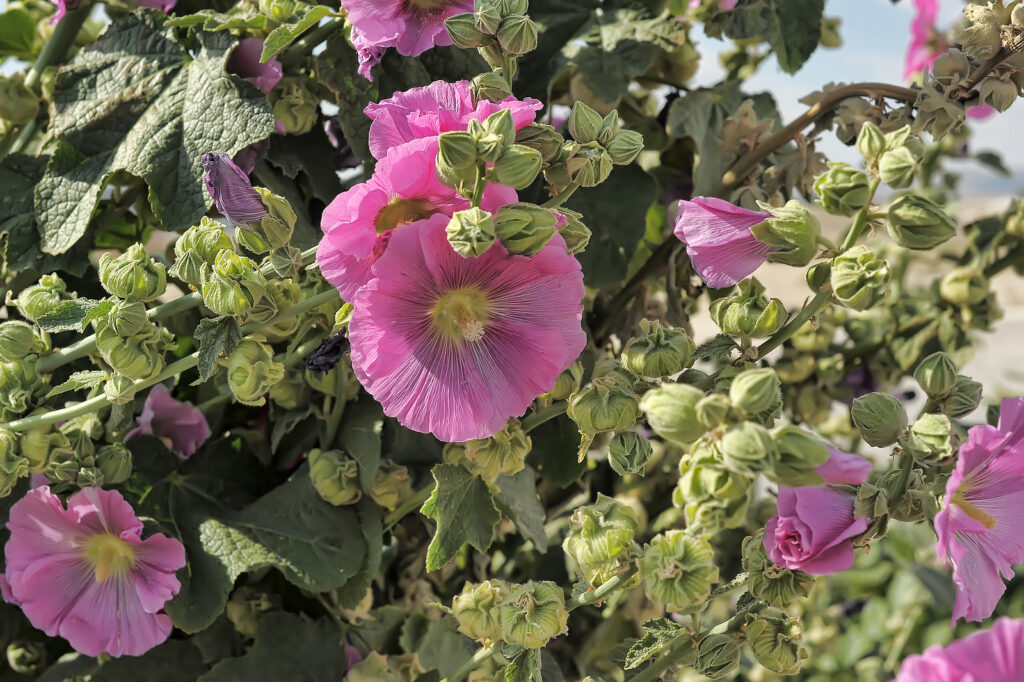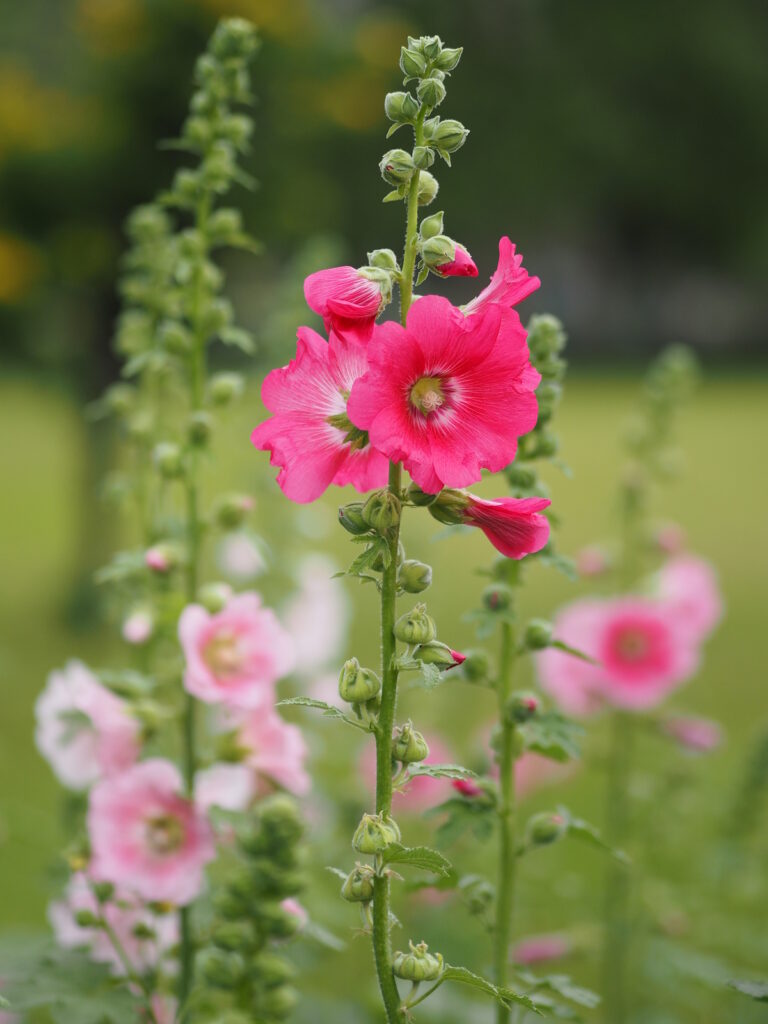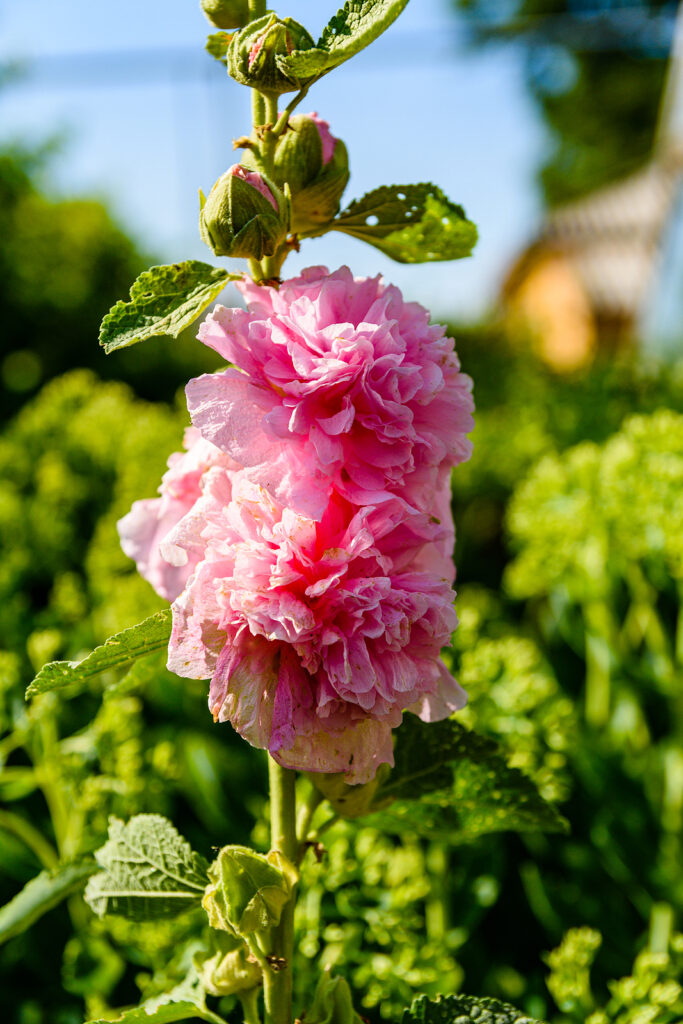Hollyhock mallow, Malva alcea, bears open funnel-shaped, purplish-pink flowers to 3 inches across. The flowers appear on terminal racemes. Hollyhock mallow is an erect, bushy perennial with heart-shaped, scalloped, light-green leaves.
Malva is a genus of about 30 species–including annuals, biennials, and perennials. The common name of the group is Mallow.
Mallows bear five-petaled, cup- or saucer-shaped flowers with petals that are somewhat squared off at the ends. The blooms are borne singly, in clusters at the leaf axils, or in racemes.
Mallows come in shades of rose and pink as well as blue, purple, and white. Leaves are rounded or heart to kidney-shaped; some are toothed and some are lobed.
Grow mallow in full sun in average to moderately rich soil. Mallow tolerates partial shade. They grow best in cooler zones.
Mallows self sow. They can be propagated by cuttings taken in spring.,

Get to know Malva alcea–hollyhock mallow
- Plant type: Perennial
- Growing Zones and range: Zones 3-8
- Hardiness: Drought tolerant in cool-summer areas of Zones 4-5
- Height and width: 24 to 36 inches (61-91cm) tall; 18 to 24 inches (45-61cm) wide
- Foliage: Rounded or heart-shaped leaves are toothed
- Flowers: Profusion of deep, five-petaled , shallowly funnel-shaped clear pink flowers like miniature 2 inch (5cm) hollyhocks
- Flower colors: Pink, red, white
- Bloom time: Midsummer to fall
- Uses: Mixed borders, plant in mass to create a summer hedge
- Garden companions: Obedient plant and balloon flower
- Common name: Hollyhock Mallow
- Botanical name: Malva; Malva alcea, hollyhock mallow, Malva moschata, musk mallow
- Family: Malvaceae
- Origin: Open, dry habitats in Europe, North Africa, and temperate Asia
Where to plant Malva alcea–hollyhock mallow
- Grow hollyhock mallow in full sun, prefers light shade in hot summer regions in Zones 6-8.
- Plant hollyhock mallow in humus-rich to average soil that is well-drained.
Malva alcea uses and companions
- Use Malva alcea in herbaceous, mixed, or shrub border or for a wild garden.
- Use Malva for vertical effect in informal borders and cottage gardens.
- Good garden companions for Malva include Artemisia, Centranthus ruber, Cosmos atrosantuineus, Delphinium, Platyfodon grandiflorus.

When to plant Malva alcea–hollyhock mallow
- Set established hollyhock mallow in the garden in spring.
- Sow seed in the garden in early spring or early summer.
Planting and spacing Malva alcea–hollyhock mallow
- Space hollyhock mallow 18 to 24 inches (45-61cm) apart.
- Sow seed 1/8 inch deep in evenly prepared soil.
How to water and feed Malva alcea–hollyhock mallow
- Hollyhock mallow needs moderate moisture in hot summer regions; keep the soil evenly moist.
- Fertilize hollyhock mallow occasionally or work in a slow-release fertilizer in spring.
Malva alcea–hollyhock mallow care
- Hollyhock mallow readily self-sows; hollyhock mallow lives only a few years. Let plants reseed to produce new plants. Mulch around plants to slow reseeding.
- Stake hollyhock mallow as needed.
Malva alcea–hollyhock pests and diseases
- Rust and Cercospera leaf spot are common.

Malva alcea–hollyhock mallow propagation
- Malva seeds germinate in 7 to 21 days at 70°F (21°C).
- Sow seed in the garden or in containers in early spring or summer.
- Root basal cuttings in spring.
Malva alcea–hollyhock mallow varieties to grow
- Malva aclea, hollyhock mallow: erect, bushy, woody-based perennial with heart-shaped light green leaves; open funnel-shaped purplish-pink flowers 2 to 3 inches (5-8cm) across; var. fastigiata is narrow and upright bearing deep pink flowers. Hardy to -30°F (-34°C).
- M. moschata, musk mallow: erect, bushy woody-based perennial with slight musk-scented leaves’ bears saucer-shaped pale pink or white flowers; grows to 36 inches high; variety ‘Alba’ has large, open cups of cool white flowers. Hardy to -40°F(-40°C).
- M. sylvestris erect to spreading, bushy woody-based perennial, occasionally biennial; open funnel-shaped pinkish purple flowers; cultivars include ‘Bibor Fehlor’ with glossy rose-purple flowers, ‘Braveheart’ with large purple flowers, ‘Cottenham Blue’ has pale blue flowers, and ‘Zebrina’, high mallow, has pale pink flowers veined with deep purple.
- Sidalcea malviflora, checkerbloom, or prairie mallow. It looks like hollyhocks with smaller leaves and smaller flowers. Hardy to -20°F (-29°C).















